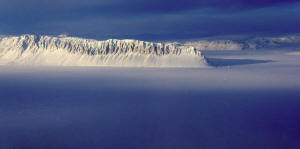|
Arctic ice loss driven by natural swings,
not just mankind: study
 Send a link to a friend
Send a link to a friend
 [March 14, 2017]
By Alister Doyle [March 14, 2017]
By Alister Doyle
OSLO (Reuters) - Natural swings in the
Arctic climate have caused up to half the precipitous losses of sea ice
around the North Pole in recent decades, with the rest driven by
man-made global warming, scientists said on Monday.
The study indicates that an ice-free Arctic Ocean, often feared to be
just years away, in one of the starkest signs of man-made global
warming, could be delayed if nature swings back to a cooler mode.
Natural variations in the Arctic climate "may be responsible for about
30–50 percent of the overall decline in September sea ice since 1979,"
the U.S.-based team of scientists wrote in the journal Nature Climate
Change.
Sea ice has shrunk steadily and hit a record low in September 2012 --
late summer in the Arctic -- in satellite records dating back to 1979.
The ice is now around the smallest for mid-March, rivaling winter lows
set in 2016 and 2015.

The study, separating man-made from natural influences in the Arctic
atmospheric circulation, said that a decades-long natural warming of the
Arctic climate might be tied to shifts as far away as the tropical
Pacific Ocean.
"If this natural mode would stop or reverse in the near future, we would
see a slow-down of the recent fast melting trend, or even a recovery of
sea ice," said lead author Qinghua Ding, of the University of
California, Santa Barbara.
But in the long term the build-up of man-made greenhouse gases would
become an ever more overwhelming factor, he wrote in an e-mail.
"Looking ahead, it is still a matter of when, rather than if, the Arctic
will become ice-free in summer," said Ed Hawkins, of the University of
Reading, who was not involved in the study.
[to top of second column] |

Eureka Sound on Ellesmere Island in the Canadian Arctic is seen in a
NASA Operation IceBridge survey picture taken March 25, 2014.
NASA/Michael Studinger/Handout via REUTERS/File Photo

The melt of the Arctic is disrupting the livelihoods of indigenous
peoples and damaging wildlife such as polar bears and seals while
opening the region to more oil and gas and shipping.
Professor Andrew Shepherd, of Leeds University, who did not
participate in the study, welcomed it as pinning down the relative
shares of natural and man-made influences. "Nobody's done this
attribution before," he said.
The findings could help narrow down huge uncertainties about when
the ice will vanish.
In 2013, a U.N. panel of climate scientists merely said human
influences had "very likely contributed" to the loss of Arctic ice,
without estimating how much. It said that the ice could disappear by
mid-century if emissions keep rising.
(Reporting By Alister Doyle; Editing by Catherine Evans)
[© 2017 Thomson Reuters. All rights
reserved.]
Copyright 2017 Reuters. All rights reserved. This material may not be published,
broadcast, rewritten or redistributed.
 |